Disaster - Genres
Characteristic elements of disaster films
A disaster film is one whose plot is based on an impending or ongoing catastrophe that the protagonists (and other people, or all of humanity) must face. The main themes are earthquakes, tidal waves, volcanic eruptions, tornadoes, large fires, collisions of space bodies with Earth, various accidents of mass transport, such as plane crashes or shipwrecks, the spread dangerous viruses, sudden environmental changes or destructive alien invasions. They can often overlap in concept with science fiction, thriller, horror or action, but their specific themes revolving around destruction of epic proportions have earned them a special category.
Some of the disasters can be interpreted as representations of fears about the consequences of human activities or other potential threats. The source of such uncertainties may be, for example, advanced technologies, discoveries in the natural sciences, activities that have a detrimental effect on the environment, or premonitions of the end of the world. Natural disasters can be perceived as the retribution of planet Earth on humans for the devastation of its surface, while hostile alien invasions usually represent the fear of triggering a war between powers (e.g. between the USA and the Soviet Union during the Cold War).
In disaster films, large numbers of people often die, usually presented by nameless masses or minor characters, but in some cases the death of one of the main characters may occur. The plots often involve multiple storylines, with the narrative alternating between the perspectives of several characters, and the extensive cast provides ample room for a large number of film stars. The heroes first try to warn of the impending danger (typically a scientist whom no one trusts), prevent or escape the disaster, then face it head-on (and ideally survive) and eventually deal with its consequences. Older films often climaxed with the disaster itself, whereas in more recent ones the disaster often occurs much earlier, sometimes even from the beginning. The biggest attraction for audiences in disaster films tends to be the monumental scenes of colossal destruction, which are the basis for later films that rely on computer effects in this respect.
Early disaster films
With a bit of exaggeration, there are a pair of shorts from the beginning of cinema that can already be described as disaster films: Fire! (1901) and Life of an American Fireman (1903), which depicted firemen rescuing victims from a burning building. Later films would be have more explicit catastrophic motifs, for example, the Italian film The Last Days of Pompeii (1908), which dealt with the life of the inhabitants of Pompeii, cut short by the eruption of Vesuvius in 79 AD, the German In Night and Ice (1912), about the tragic collision of the Titanic with an iceberg, and the Danish The End of the World (1916), in which Earth is threatened by a comet. The American film Noah's Ark (1928) was inspired by the biblical story of the flood, while Deluge (1933), remarkable by its visual effects, saw the skyscrapers in New York City collapse due to an earthquake and the ruins being washed away by a giant tidal wave.
Musical drama and disasters based on real events were combined in San Francisco (1936), released on the anniversary of the great earthquake of 1906, and In Old Chicago (1937), set during the devastating fire of 1871. In John Ford's The Hurricane (1937), a devastating tropical storm wipes out an entire Pacific island, and in The Rains Came (1939), set in colonial India, earthquakes, heavy rains followed by floods and a cholera epidemic were part of a romantic plot. The Titanic shipwreck inspired the British film Titanic: Disaster in the Atlantic (1929), which depicted the turbulent events of its sinking. It was also the subject of the propagandistic German film Titanic (1943), the American Titanic (1953) and especially the British A Night to Remember by Roy Ward Baker (1958). An imminent airplane crash was the subject of The High and the Mighty (1954), in which the passengers of a plane that lost one of its engines find themselves in a dangerous situation. Typhoon Over Nagasaki (1957), a French-Japanese co-production, featured a devastating typhoon in the story of a love triangle, while The Devil at 4 O'Clock (1961) and Krakatoa, East of Java (1969) featured volcanic eruptions.
In Night and Ice (1912)
Photo © Continental Kunstfilm
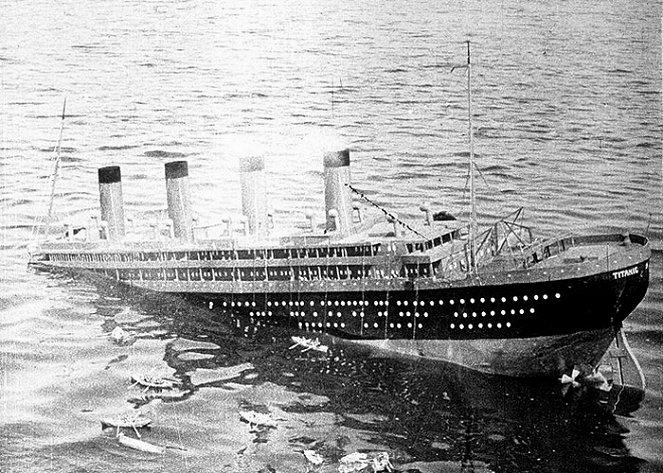
Disaster films of the 1950s and 60s
After the end of World War II, there were a number of science fiction films about alien invasions, which often did not come without destruction and loss of life. Typical representatives in this regard were Byron Haskin's The War of the Worlds (1953), in which the aliens possessed advanced technology that Earth's weapons could not match, Don Siegel's Invasion of the Body Snatchers (1956), in which the invasion was carried out by kidnapping humans and replacing them with soulless imitations hatched from alien cocoons, and Earth vs. the Flying Saucers (1956), in which the audience could enjoy a number of explosions and collisions of flying saucers with buildings. Catastrophic sequences of urban destruction also featured heavily in films thematising the beginning of the atomic age through battles with giant monsters or overgrown animals, for example, The Beast from 20,000 Fathoms (1953), Behemoth the Sea Monster (1959), Gorgo (1961), and also in the Japanese Godzilla (1954).
In Rudolph Maté's 1951 science fiction film When Worlds Collide, selected representatives of humanity attempt to escape from Earth in an ark before a collision with an alien planet; in The Night the World Exploded! (1957), scientists face a never-ending string of extreme earthquakes, and in the British film The Day the Earth Caught Fire (1961), humans have to deal with the disappearance of water and the changes in climate caused by the tilting of the Earth's axis, which brings it closer and closer to the Sun. In the science fiction film Crack in the World (1965), what was at stake was saving the world from the spread of a huge crack in its surface, created by a group of scientists who detonated an atomic bomb in the Earth's interior with the intention of drawing energy from its core. Panic in Year Zero! (1962) showed the changes in human mentality through a story in which the United States was attacked with nuclear weapons.
Godzilla (1954)
Photo © Toho Co., Ltd. All Rights Reserved
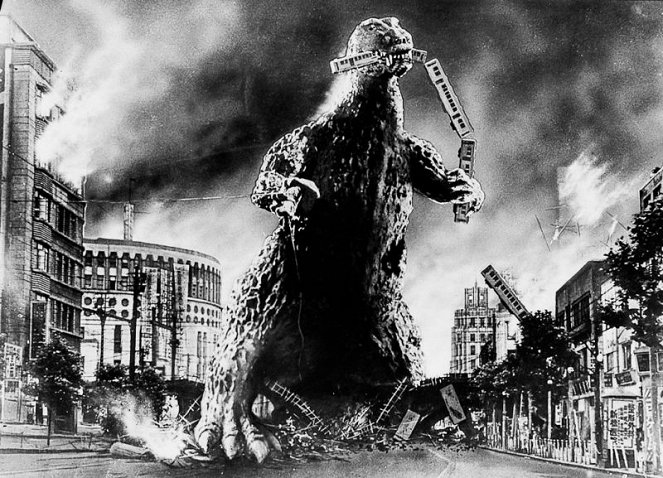
The heyday and subsequent decline of the disaster genre in the 1970s
Disaster films reached their imaginary peak in the 1970s. The golden era was ushered in by the premiere of Airport (1970), in which, in addition to a snowstorm, the passengers were threatened by a suicide bomber. Nominated for ten Academy Awards, the film was an extraordinary success and was followed by three sequels (in 1974, 1977 and 1979), which were later mocked in the parody Airplane! (1980). Eight Oscar nominations were awarded to director Ronald Neame's much-lauded The Poseidon Adventure (1972), which featured the passengers of a sinking ocean liner turned upside down by a tidal wave, and John Guillermin's equally lauded The Towering Inferno (1974), which revolved around the rescue of people from the upper floors of a burning luxury skyscraper whose security system had been compromised by greedy investors. Similarly successful was Mark Robson's Earthquake (1974), a four-Oscar-nominated tale of heroes defying a devastating earthquake in California, whose theatrical release was accompanied by a powerful sound system that created a shuddering sensation in the audience by rumbling and vibrating during the catastrophic scenes.
The surging popularity of disaster films was immediately followed by several other releases, including. The Hindenburg (1975), about the fate of the famous German airship, Rollercoaster (1977), a thriller about amusement park disasters, Avalanche (1978), about an avalanche that threatens mountain hikers, and several television films, including The Day the Earth Moved (1974), Flood! (1976) and Fire! (1977). But the popularity of disaster films in Hollywood would wane considerably after the failures of Hurricane (1979), a remake of the 1937 film The Hurricane, Ronald Neame's Meteor (1979), in which the US and the Soviet Union have to work together to divert the path of a meteor threatening to collide with Earth, and the Canadian City on Fire (1979), about a fire at a downtown refinery.
Also flops were two films directed by Irwin Allen, producer of The Poseidon Adventure and The Towering Inferno. The first was The Swarm (1978), about killer bees threatening a city, followed by the sequel to The Poseidon Adventure called Beyond the Poseidon Adventure (1979), in which the sunken ship becomes the focus of a criminal captain and his crew. The disaster film genre almost disappeared during the 1980s, with only a few representatives being produced, such as The Day After (1983), a TV film about a nuclear war between the Americans and the Soviets, and Threads (1984), a British TV film about the effects of a global nuclear war on the UK.
The Poseidon Adventure (1972)
Photo © Twentieth Century Fox Film Corp.
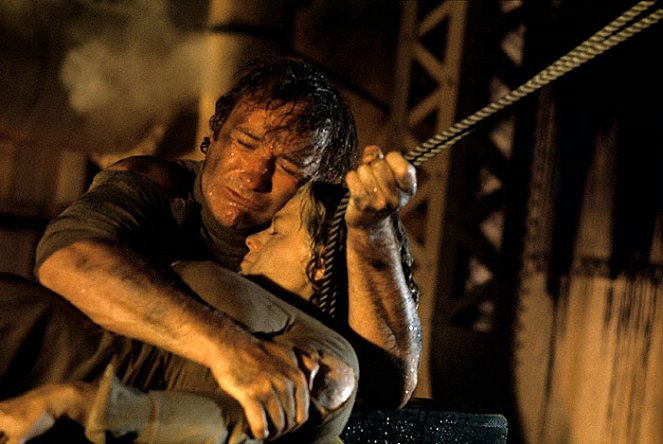
Pandemic films and the zombie apocalypse
Pandemic films deal with the theme of deadly viral or bacterial epidemics and their spread across the world, which tend to be portrayed as quite intense and can often be interpreted as the final step in the disintegration of an already quite unhealthy society or as a form of divine punishment. For example, in George A. Romero's paranoid thriller The Crazies (1973), the atmosphere of contagion was used to depict the mood of society after the Vietnam War; in David Cronenberg's body-horror Rabid (1977), the virus awakens in its victims an uncontrollable appetite for blood; and Terry Gilliam's sci-fi film 12 Monkeys (1995) is set in a world where scientists are trying to reverse the contagion responsible for the extinction of most of mankind by sending people into the past. In M. Night Shyamalan's The Happening (2008), people lose their instinct for self-preservation and commit suicide as a result of a viral infection; in Blindness (2008), the heroes gradually lose their eyesight; and in Perfect Sense (2011), the virus deprives the infected of their sense of smell and then their sense of taste and hearing. The motif of the last surviving man on the planet was used in films such as The Last Man on Earth (1964) and I Am Legend (2007).
The fight against a dangerous substance was the subject of, among others, The Andromeda Strain by Robert Wise (1971), about an alien microorganism infecting many people, and The Cassandra Crossing by George P. Cosmatos (1976), about a virus spreading among the passengers of an international train. The star-studded Outbreak by Wolfgang Petersen (1995) portrayed the world affected by a deadly virus and people's reactions to the epidemic in a quite realistically and extremely frightening way. It was successfully followed by Steven Soderbergh’s Contagion (2011), which also portrayed very believably the atmosphere of fear spreading in society and the behaviour of characters facing a dangerous pandemic. Films about bacterial infections include Pacific Liner (1939), a drama about the chaos on a ship caused by a stowaway suffering cholera; Panic in the Streets (1950), a film-noir about criminals who inadvertently spread pneumonic plague in the city; and The Seventh Seal (1957), set against the backdrop of a plague outbreak.
A special chapter of pandemic films is the zombie movie, in which a viral infection turns people into reanimated corpses, attacking other individuals in their lust for human flesh and brains. In this respect, George A. Romero's Night of the Living Dead (1968) and Dawn of the Dead (1978) are classics of the genre that fundamentally influenced the development of horror and gave birth to a successful film franchise. At the beginning of the new millennium, Danny Boyle's 28 Days Later (2002) and Zack Snyder's Dawn of the Dead (2004) were breakthrough films in the genre. Also very popular was the computer game-inspired Resident Evil franchise (2002-2016), followed by the Spanish horror film REC (2007), the American World War Z (2013) and the South Korean Train to Busan (2016). The heroes of the comedies Shaun of the Dead (2004), Zombieland (2009) and Dead Snow (2009) also faced deadly zombie outbreaks.
The Cassandra Crossing (1976)
Photo © International Cinemedia Centre Ltd.
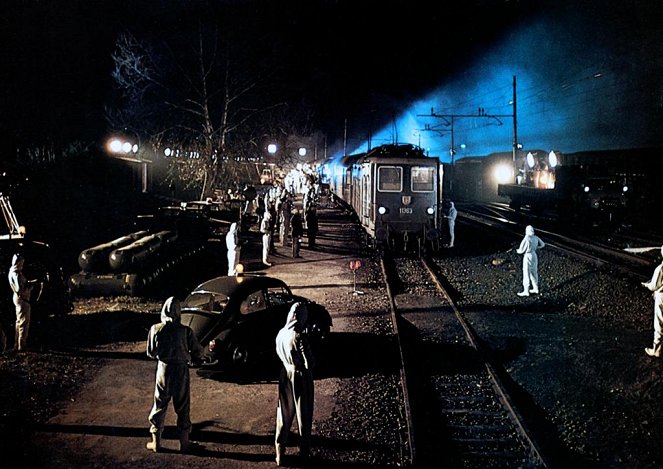
The renaissance of disaster films in the 1990s
In the 1990s, the rise of special effects, modern technology and CGI led to a resurgence of big-budget science fiction and disaster films. This trend was kicked off by two big hits: Jan de Bont's Twister (1996), which demonstrated the full effect of devastating tornadoes, and Roland Emmerich's Independence Day (1996), which offered spectacular explosive destruction caused by alien ships. They were followed by Titanic (1997), in which director James Cameron combined the well-known story of the tragic sinking of an ocean liner with a fateful romantic drama to create by far the highest-grossing film of all time (until 2009, when it was surpassed by Avatar), and turned in eleven of its fourteen Oscar nominations.
Mimi Leder's Deep Impact (1998), in which Earth is threatened by an approaching comet, and Michael Bay's Armageddon (1998), in which a group of oilmen are tasked with drilling through an asteroid the size of Texas and destroy it with a nuclear bomb, were both hits. Other films that fell into the disaster genre were Daylight (1996), about a group of people trapped in a waterlogged tunnel under a river after a toxic waste explosion, Dante's Peak (1997) and Volcano (1997), in which the protagonists deal with the eruptions of raging volcanoes, Hard Rain (1998), in which persistent rains cause widespread flooding in cities, and Wolfgang Petersen's The Perfect Storm (2000), which tells the story of a fishing boat crew's battle with an extremely rough ocean. In addition, there were many disaster B-movies, such as Asteroid (1997), made for TV, the action film Turbulence (1997) and the direct-to-video film Tycus (1999).
Volcano (1997)
Photo © 1997 20th Century Fox
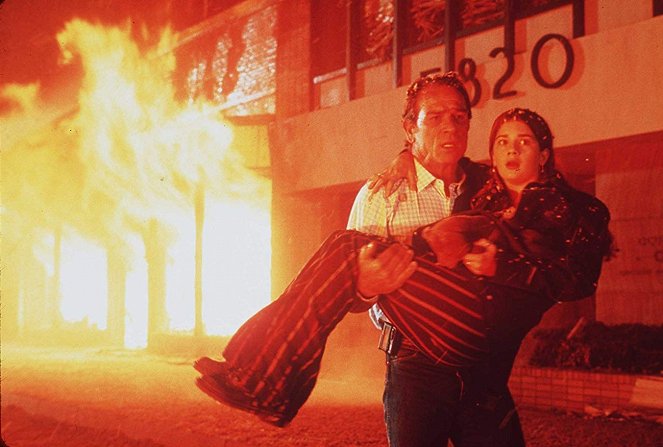
Disaster films of the new millennium
Disaster films based on epic scenes of destruction continued to flourish after 2000 and, thanks to the constant development and improvement of digital effects, they became increasingly realistic, in contrast to their usually somewhat far-fetched premises. For example, in The Core (2003), the rotation of the Earth's core stops and a group of scientists attempt to prevent the destruction of the planet detonating a nuclear bomb inside it. In The Day After Tomorrow (2004), directed by Roland Emmerich, sudden climate changes and weather fluctuations due to global warming result in tidal waves, hurricanes, tornadoes and rapid cooling of the northern hemisphere, among other things. Emmerich then exploited the existential angst associated with the end of the world predicted by the Mayan calendar with 2012 (2009), in which mutations in the Earth's superheated core caused by solar flares trigger destruction of biblical proportions, from which chosen representatives of humanity plan to save themselves in special ships modelled on Noah's Ark. Wolfgang Petersen returned to disaster movies with Poseidon (2006), a remake of 1972's The Poseidon Adventure.
The catastrophic aftermath of alien invasions was depicted in Steven Spielberg's War of the Worlds (2005), Scott Derrickson's The Day the Earth Stood Still (2008), Jonathan Liebesman's Battle: Los Angeles (2011), and Emmerich's sequel to Independence Day, Independence Day: Resurgence (2016). The thriller Knowing (2009) and the comedy This Is the End (2013), among others, revolved around various disasters and the potential end of the world. Colossal destruction of various cities was also present in some superhero films, such as Watchmen (2009), The Avengers (2012), Man of Steel (2013) and Justice League (2017). In the sci-fi film Transformers: Dark of the Moon (2011), Chicago is attacked by giant alien robots; in G.I. Joe: Retaliation (2013), London is destroyed; and in Pacific Rim (2013), giant monsters attack the world's capitals. The citizens of New York also had to deal with a giant monster demolishing buildings in Cloverfield (2008).
More classic disaster spectacle abounded in Into the Storm (2014), depicting people's struggle with windstorms, San Andreas (2015), about the aftermath of a massive earthquake, and Greenland (2020), whose heroes set out to seek refuge from a comet's fall, while Peter Berg's Deepwater Horizon (2017) was based on an actual floating oil rig fire in 2010. Devastating tidal waves were a feature in Clint Eastwood's Hereafter (2010), Spain's The Impossible (2012), Norway's The Wave (2015), and the American Geostorm (2017), in which a malfunctioning satellite system that was supposed to monitor global climate causes a series of disasters. The historical film Pompeii (2014), Russia's Metro (2013), South Korea's Pandora (2016) and Norway's The Quake (2018) also offered catastrophic sequences. Like in the 1990s, there was a large number of low-budget direct-to-video disaster films, including the two-part Supernova (2005) and the Canadian TV series Doomsday Prophecy (2011).
Filmmaniak
Best disaster films
Titanic (1997) |
The Towering Inferno (1974) |
The Impossible (2012) |
The Poseidon Adventure (1972) |
The Day the Earth Stood Still (1951) |
A Night to Remember (1958) |
Godzilla Minus One (2023) |
Deepwater Horizon (2016) |
Armageddon (1998) |
Don't Look Up (2021) |
| All the best disaster films |